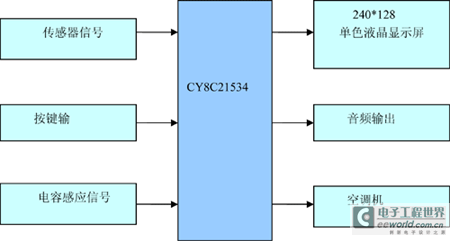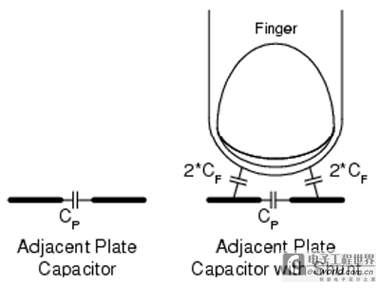Design of automotive center console panel based on capacitive sensing technology
Design of automotive center console panel based on capacitive sensing technology
This article describes the development of Cypress's PSoC (Programmable System-on-Chip) CY8C 21534 series chip for use in automotive center console panels. The working principle of the panel and its innovative exterior design focus on the principle of capacitive sensing technology and its advantages in panel control. The market prospect and commercial value of this center console panel are also analyzed.
Background introduction
With the development of automotive electronics technology today, there are more and more electronic devices on the car, and it has become a necessity to control and coordinate these electrical devices through on-board computers. However, the higher the vehicle, the more electronic devices there will be, and the more complicated the operating system of the onboard computer will be. If every function corresponds to a button, imagine how dazzling the car's center console will be. In this case, how to make the operation interface simple and practical becomes a problem that has to be considered. Referring to the operation interface of the iPod, we developed a car center console panel based on capacitive sensing technology, which greatly reduced the buttons, the appearance is simple and beautiful, and the operation is interesting.
The center console panel of this car has the following functions:
1. Record driving data: Driving data on the homepage includes driving time, mileage, fuel usage, average fuel usage, and average speed. Each time the data is recorded once, the user can also flip through the previous records.
2. Display of time and date: This part of the function is integrated on the right side of the screen. Displayed under any interface.
3. Temperature display: simultaneously display indoor and outdoor temperature.
4. Multimedia player: This system interface supports MP3 playback, CD playback and radio mode. This part of the function makes extensive use of Cypress capacitive sensing technology to make entertainment more interesting.
5. Air conditioning control: This part includes common control functions such as temperature control and wind control.
Overall system design
System structure and interface design
This system uses the 21534 series chip provided by Cypress, which features integrated capacitive sensing module CSR, which can be directly configured in use, which provides great convenience for the design related to capacitive sensing. The chip has four digital module positions and four analog module positions. Although limited, the chip is mainly designed for capacitive sensing control, so a capacitive sensing module is placed on the chip (occupying three digital module positions). And an analog module location) and the counter module necessary to implement some controls (occupying a digital module location) is just right. (If necessary, you can also use dynamic redistribution techniques to join other modules).
The system block diagram is shown in Figure 1.

Figure 1 system block diagram
The display device adopts a four-gradation black-and-white liquid crystal display with a resolution of 240×128 pixels, and can be divided into four layers without any character layer. In this design, two layers of display are used, wherein the first layer is a character layer, which can display 176 letters, numbers, symbols, etc., which are included in the ROM, and the second layer is a picture layer, which can control any point on the display screen. To display the desired graphic. The relationship between the second layer and the first layer is set to be NAND, so that the effect of the reverse color display can be displayed when the menu is selected, which is also widely used in the selection of LCD screens such as computers and mobile phones. The backlight of the screen adopts the timing control mode, that is, the backlight is turned on after 15 seconds of pressing the button, and the information is still displayed after 15 seconds but the backlight is off, which can affect the use and have lower power consumption.
The display information includes basic information and function information, which are respectively divided into two parts separated by vertical lines on the screen. The basic information includes information such as time, date, indoor and outdoor temperature, etc., which need to be displayed at the moment, but does not need to change position frequently and does not need to be controlled by a button. The fixed position on the right side of the screen has a certain visual stability. The function information includes an information display interface when the FM, CD, air conditioner, etc. work, and is located on the left side of the screen.
Due to the shape design limitation, the number of buttons is very limited, so the same button must be configured with different control functions under different interfaces to effectively control the system. In the program, the button variable is assigned every time the button is pressed, and how the display is displayed depends not only on the variable button, but also on the current display interface to achieve the correct operation after pressing the button. In addition, the central button also adds a long button function, that is, pressing the center button for more than 1 second will achieve a function different from a single press to expand the function of the button, which is equivalent to increasing the number of buttons.
Capacitance sensing principle and application
The Capacitor Sensing Module (CSR) consists of a capacitive sensor array, an analog multiplexer, a capacitive sensing relaxation oscillator, and a counter. The structure diagram is shown in Figure 2.

Figure 2 Schematic diagram of the capacitor sensing module
Capacitive sensors are typically constructed of a capacitor that is formed between a copper sheet that covers the PCB and ground. The copper sheet is covered with a layer of insulating material. When the conductor is close to the capacitor, as shown in Figure 3, the capacitance between the copper and ground will change. A capacitively-induced relaxation oscillator produces a square wave of a different frequency for different capacitances. The pulse width modulation module and counter calculate the frequency of the output. By detecting the value of the counter and comparing it with the set threshold, the opening and closing of the capacitive sensing switch can be interrupted.
The software part integrates an algorithm that compensates for differences in environmental characteristics and sensor physical characteristics. It also recognizes the logo of the button, the position of the slider, and the position of the two-dimensional touchpad, making the capacitive sensing switch stable.

Figure 3 Principle of capacitive sensing
Capacitive sensing is made into a slider in this design. When the finger slides on it, it can change the specific amount under the specific interface, such as the volume under the multimedia, the air volume under the air conditioning interface. Compared with traditional mechanical switch knobs, the application of capacitive sensing sliders is durable, beautiful and easy to operate. The driver does not have to precisely align the button to adjust, but rather adjusts the blur towards the position of the slider.
According to the principle of capacitive sensing, the design of the PCB slider of this design is shown in Figure 4.

Figure 4 Design of a capacitive sensing PCB
Shape design
Compared with the various center console panels on the market, the design of this center console has a strong visual impact. The gray-white display and control section is embedded in the black imaginary body, while the black buttons are embedded in the white operator interface for a contrasting, stylish look. There are no messy buttons on the entire operation interface, and the circular touch screen is matched with the buttons around the circumference, which is both symmetrical and does not give a monotonous feeling. As shown in Figure 5.

Figure 5 car panel design
software design
The software part of this design occupies 8K of FLASH capacity, and the input of the key is queried through a main loop, and then combined with the current interface to combine a task. Software flow chart:

Figure 6 software system flow
Advantages and innovation
Simple operation interface
Abandoning the traditional multi-button design, the operation interface consists of only five buttons and a capacitive sensing slider, and can still effectively control multimedia systems including FM radio, multi-disc CD player, DVD player, and car air conditioner. , time and date display, temperature display inside and outside the car and system settings. The five buttons can realize different control functions under different conditions, and will not affect the use of the buttons. Moreover, the keys are dispersed, and the correct operation can be performed as long as the orientation is roughly determined. Compared with the full-key center console that also implements the above functions, the capacitive sensing center console has its unparalleled advantages in appearance. The simple operation interface design not only gives a visually fresh feeling, but also uses it. It is also possible to avoid the driver's misoperation caused by too many buttons, too dense, or to lengthen the time to find the button.
fashion appearance
Integrating the design elements of the iPod into the car's center console system is a combination of fashion and technology, which is what designers have been pursuing. The innovative design will change the practical concept of most car center consoles in the past, and truly make the car center console a piece of art, giving people a different feeling.
High integration
Using only one piece of Cypress 21534 series chip, using its own integrated capacitive sensing module, and assisting with a few buttons to control a variety of functions on the car, replacing the traditional multi-button interface, the integration is higher. In this design, almost all the pins of the 21534 series chip are used, and the memory usage is close to 100%, which fully plays the role of this chip. Here, due to the limitations of the conditions, the various controls are simulated by liquid crystal. In practical applications, the pin multiplex can be used to drive the actuator at the same time, realizing the requirement that one chip replaces multiple chips. Even if a chip is separately allocated to control the liquid crystal display in practice, the design is highly integrated.
Save development time
Using the capacitive sensing module integrated in the Cypress21 series chip to develop the inductive car center console operating system, compared with other single-chip microcomputers, first has advantages in time and programming, while saving time and effort. In addition, the modular programming method of the PSoC system is very convenient, and the API function can be directly called, which greatly shortens the chip development time. Visualizing the configuration of system, module, and pin parameters has the advantage of not forgetting the configuration of a parameter, and without having to remember the register name and the specific meaning of each bit, and also saves time in reviewing the manual.
Application of capacitive sensing technology
This is the most distinctive design of this center console. Capacitive sensing control has an unparalleled advantage over traditional button control. First of all, the shape of the slider can be arbitrarily determined, providing a possibility for a circular sensing area, which provides a premise for an aesthetic shape design. Secondly, the capacitive sensing portion is composed of a metal diaphragm on the circuit board, covering the wear-resistant surface covering member, and does not cause wear or failure due to too many pressing times, and the reliability is much better than that of the ordinary button. Third, the design of the slider can be quickly increased or decreased when selecting menus and adjusting some analog quantities (such as volume, air conditioning temperature, wind power, etc.), eliminating the need to repeat the button multiple times, saving operating time. The convenient and quick operation really meets the requirements of people for the control interface. Fourth, the introduction of capacitive sensing technology into automotive panels, not only because the reduction of buttons reduces the complexity of car panel opening, manufacturing, and assembly, but also increases the convenience and fun of use - tired of the widespread use of buttons After the interface, the sliders are really interesting and therefore more attractive. Driving pleasure is not only provided by traditional car performance, but the small center console panel also makes the driving process pleasant and fun.
The 1U Brush Cable Management Panel mounts to a standard 19" rack to organize cables while keeping dust and dirt out of the rack. Constructed of high-quality steel with high-density nylon bristles, the 1U brush plate creates a clean looking point of entry and offers cable separation for simple cable organization. The brush panel also promotes proper airflow through the rack by closing off open spaces between equipment, this cable organizer comes complete with 2 sets of rack screws for easy installation.
Brush Type Cable Management,Brush Cable Management,1u brush panel,1U Cable Management
NINGBO UONICORE ELECTRONICS CO., LTD , https://www.uonicore.com